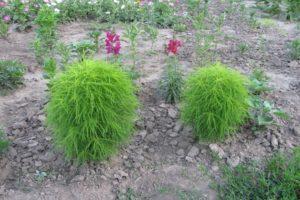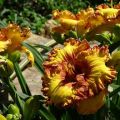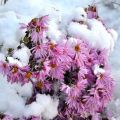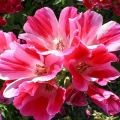Rules for growing nigella from seeds and description of varieties
Growing nigella from seeds is an interesting process that allows you to get good results. This herbaceous culture has excellent decorative properties and provides a healing effect. Today, many varieties and varieties of nigella are known, which differ in appearance and other characteristics. Thanks to this, every gardener can choose the appropriate option.
Description and features
Nigella is often called nigella. It is an annual herb that reaches 60 centimeters in height. The culture is characterized by a straight stem with a large number of branches. The plant is distinguished by blue, white, blue flowers. There are also pink buds. Combined with bright, pinnately dissected leaves, the flowers look beautiful.
Nigella inflorescences are solitary. They are simple and terry. The composition includes a calyx with 5 sepals, 5-8 petals, a large number of large stamens and pistils. Flowering lasts from May to August. After its completion, the bush does not lose its decorative properties. This is due to the appearance of unusual bolls filled with seeds..
The culture is considered light-loving. It is resistant to cold and easily tolerates spring frosts. Reproduction is carried out by seeds. They have a black shade and a triangular shape.
Landing in open ground
To plant a crop in open soil, it is worth following a number of important recommendations.
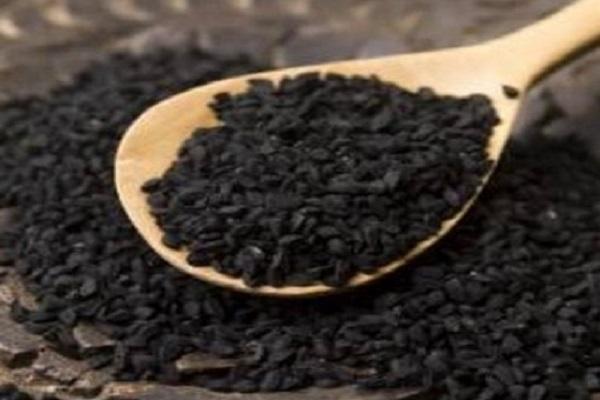
Seat selection
The plant likes lighted, unshaded places. It is important to choose the right site for planting. In the shade, the culture begins to bloom later. In this case, the flowers bloom at different times, and therefore the seeds do not have time to ripen.
Soil requirements
For the full development of nigella, loose nutrient soil is suitable, which is characterized by a neutral reaction. Culture grows poorly on acidic soil. In such a situation, it is recommended to lime the beds in the fall.
Sowing dates
You can sow seeds in the soil in May or before winter, deepening them by 2 centimeters. Seedlings are resistant to low temperatures. However, at first, it is recommended to cover crops. Transplanting sprouts is not worth it. It is recommended to immediately plant them in a permanent place.
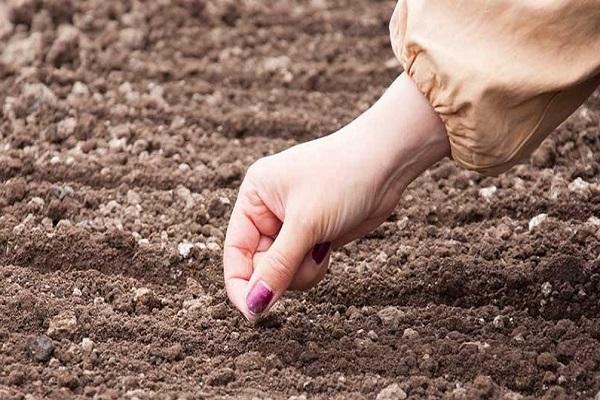
Landing scheme
For each square meter of the plot, take 1-1.5 grams of plant seeds. It is recommended to plant them in rows. It is worth keeping a distance of 20 centimeters between them.
Growing through seedlings
Nigella can be grown in seedlings. In this case, it is worth following some recommendations.
When and how to plant
For seedlings, seeds should be planted in March or April. In this case, they are buried in the ground by 2 centimeters. The sprouts appear in 2-3 weeks.
Dive
This procedure is carried out when 2 true leaves appear. The sprouts are transplanted into peat-humus pots. Directly in them it is worth transplanting seedlings to the garden.
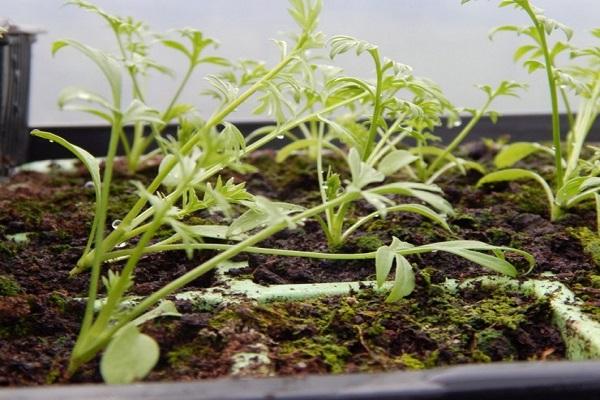
Landing in open ground
When the time comes, seedlings should be planted in the garden. This process has some peculiarities.
Seat selection
For nigella, it is worth choosing an open and sunny area. Culture grows poorly in the shade.
Soil requirements
Nigella loves loose and dry soil. It should be lightweight. In this case, the composition must contain nutrients. It is important that the soil is neutral or calcareous. In acidic soil, the culture does not develop well.
Timing
Nigella seedlings develop quite quickly. Therefore, it should be transplanted into open ground in May.

How to drop off
The sprouts are transferred to the ground in peat pots. In this case, it is recommended to observe an interval of 15-20 centimeters. It is worth maintaining a distance of 45-50 centimeters between the rows. Planting more often will result in no flowering and no seeds.
After planting, the garden should be watered. At the same time, mulching the soil is not recommended. Nigella does not respond well to this procedure.
Care
To provide a culture with proper care, it is important to properly care for it. For this, a number of recommendations are followed.
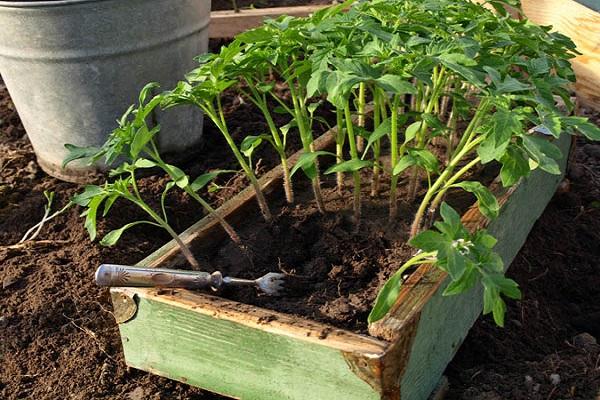
Watering
Watering the crop should be moderate, but regular. She hardly accepts excessive soil moisture. If you do not water the nigella for a long time or use too much water, there is a risk of plant death.
Loosening and weeding
This plant is considered to be very moody. It is recommended to constantly weed and loosen it. In this case, weeding should be carried out carefully so as not to provoke root damage. It is important to loosen the soil after watering to provide oxygen to the roots.
Top dressing
It is not recommended to feed Nigella with fresh organic fertilizers or use a lot of nitrogenous substances. This greatly delays the growing season. As a result, it will not be possible to collect ripe seeds. During the flowering period, it is worth bringing phosphorus-potassium preparations under the nigella.
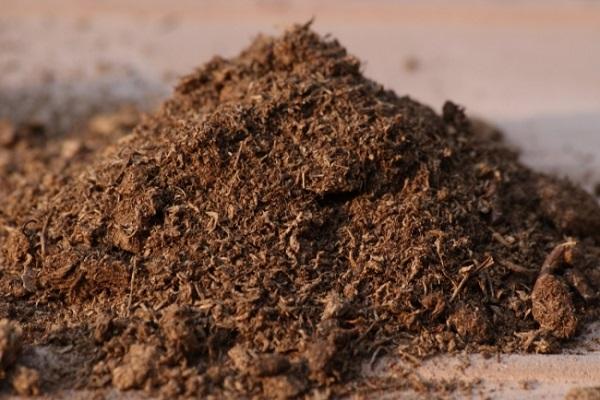
Reproduction
There is only one method of propagating a culture. This is done with seeds. They are planted directly in the soil or used to grow seedlings. After flowering, the plant can be sown independently.
Diseases and pests
Nigella is resistant to diseases and harmful insects. This is due to the strong odor that repels parasites. However, sometimes problems do arise.
Powdery mildew
This disease develops if wet and cool weather is observed for a long time. To deal with the problem, it is worth using fungicides. The plant should be treated with such preparations 2-3 times every 7 days.
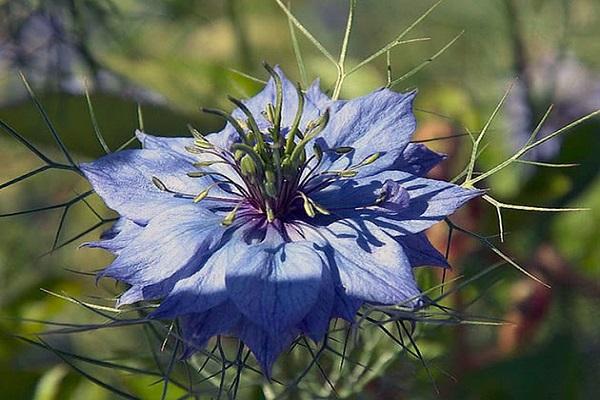
Spider mite
In dry weather, in the absence of timely watering, spider mites can infect the plant. Parasites suck out all the juices from the culture. To cope with ticks, Nigella should be sprayed with chemicals. For this purpose, substances such as Akarin, Actellik are suitable.
After flowering
After the seed pods have ripened, they begin to collect the seed. It is recommended to use it for growing crops next year. Seeds are harvested in late summer or early fall.
For this, dry stems with seeds should be cut and hung in bunches in a ventilated room.It is recommended to remove well-dried seeds from the capsules. They remain viable for several years. It is allowed to plant a crop in a flowerbed in spring or late autumn.

Kinds
There are quite a few varieties of nigella that have certain characteristics.
Damascus
It is this variety that is most often found in gardens. It is an unpretentious ornamental crop that has beautiful flowers and leaves. The stems grow 30-50 centimeters tall.
The culture is characterized by dissected leaves. It also has white, blue or blue flowers. There are many varieties of Damascus nigella that allow you to choose the right option.
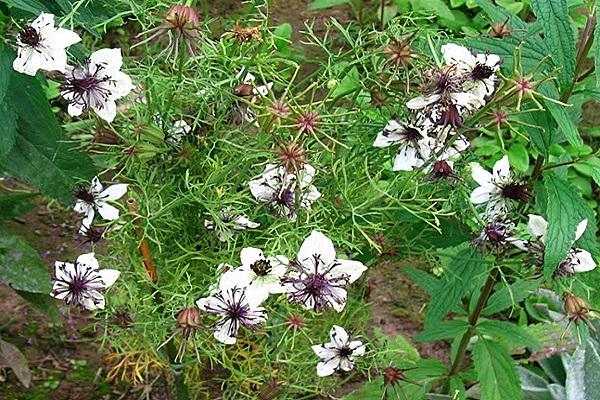
Sowing
This plant is also called Roman coriander. It resembles Damascus nigella, but is characterized by smaller flowers. They are distinguished by a white, bluish, yellow tint.
The seeds of the crop have a pronounced spicy aroma. This variety is often used to enhance the flavor of food. Also, dry bouquets of seed nigella help fight moths.
Spanish
This plant is somewhat less common. In height, it reaches 60 centimeters. The culture is characterized by dark green leaves and rich blue flowers. They are 6 centimeters in diameter. Inside you can see bright stamens. The plant blooms from June to September.

Eastern
This culture became more widespread in Asia. It has ugly flowers with practically no petals. The rest are bent downward. The bush has a straight stem and branched shoots covered with long leaves.
Popular varieties
Nigella has many varieties that differ in certain characteristics. This allows gardeners to choose the most suitable flower bed solution.
Cambridge Blue
This beautiful plant is characterized by large flowers. They are distinguished by a bluish blue tint. The bush reaches 1 meter in height and is covered with lace leaves. It is this type of nigella that is most often chosen for decorating flower beds.

Miss Jekyll Rose
This variety is characterized by large flowers. They can have red or purple hues. The box contains red seeds. The plant has a straight stem, the height of which does not exceed 50 centimeters.
Persian Jewels
The plant is characterized by pink, white, red flowers. Long green stamens can be seen in their center. This variety has thin leaves that form a delicate lace on a small stem.
Dwarf Moody Blue
This variety is a dwarf species of Damascus nigella. It is characterized by small truncated leaves that form a cloud. That is why the plant was named "blue fog". The stem reaches 25 centimeters in height. The flowers are small and have a blue or blue tint.
Baby Blue
It is an unattractive variety with small, pale flowers. It also has small, curved stems. Their height does not exceed 20 centimeters.

Sativa
This plant can be used for medicinal purposes. The culture reaches 30-70 centimeters in height and has white, blue or yellow flowers. The leaves are finely cut and resemble fennel grass.
Healing properties
The culture is grown not only for decorative purposes. It is of great benefit to the human body and is used for food. The seeds of the plant are characterized by intense strawberry aroma and taste. They can be added to food.
Nigella leaves are also considered edible. They have a tonic effect on the body and help to improve well-being.
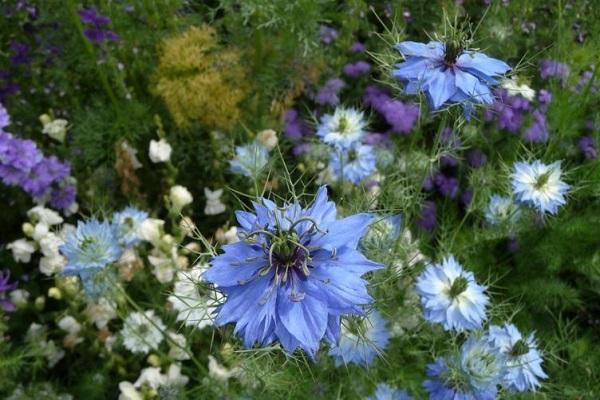
Plant seeds contain many beneficial elements. These include vitamins E and C. Also, the product contains a lot of essential oils. Due to this, it has general tonic properties.
Nigella fruits are actively used in traditional medicine. They are used to combat cystitis, dysbiosis, pyelonephritis.The seeds are useful for diabetes, oncology, asthma, epilepsy.
Infusions based on them improve metabolism and cleanse the body of harmful elements. Such funds are used during the period of weight loss. They slow down the aging process and improve memory.
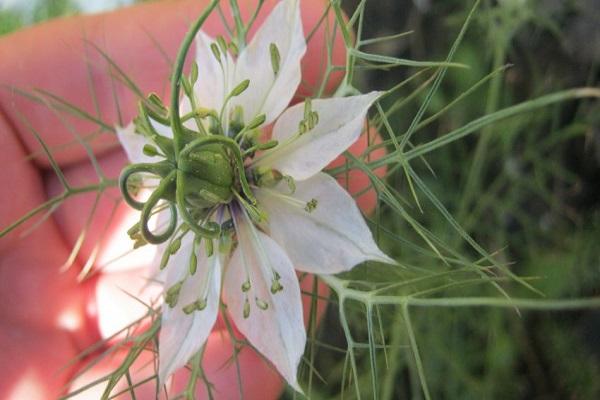
To make a useful remedy, it is worth taking nigella seeds and mixing with vodka in a 1: 5 ratio. Remove to a dark place and leave for 1 week. Then strain the liquid and transfer to the refrigerator. The resulting product is used for pathologies of the respiratory organs. A single dose is 10-15 drops.
Nigella helps control mosquitoes and moths. The plant has a specific scent that helps repel insects.
It should be borne in mind that the plant has contraindications. It should not be used during pregnancy, ischemia, gastritis. Also, gallstone disease is referred to the restrictions.

Application in landscape design
Nigella has excellent decorative properties. Therefore, it is often used in landscape design. There are many uses for this plant:
- The flower fits organically into dry gardens and rockeries.
- Nigella is often planted near artificial reservoirs and decorative fountains. This plant is characterized by lightness and accuracy.
- Nigella also looks attractive along the curbs. The plant forms a bright pattern.
- Nigella will adorn any flower bed. She will not get lost even in a bright floral arrangement.
- An excellent option would be to decorate an alpine slide. The combination with cornflowers and petunia will be especially effective.
Nigella is a beautiful plant that has beneficial properties and is actively used in landscape design. This culture is considered unpretentious, because many gardeners love it and is often planted in plots.
